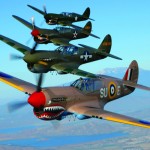Flight Training – Coordinated Flight
 No, uncoordinated flight does not involve flying while cross-eyed. In aviation, coordinated flight of an aircraft is flight without sideslip. When an aircraft is flying with zero sideslip, the inclinometer on the bottom of the turn coordinator (the little black ball in the liquid) on the aircraft’s instrument panel will show the ball in the center of the smile. This indicates that there is no lateral acceleration of the aircraft and occupants perceive their weight to be acting straight downwards into their seats. To get really technical, centrifugal force equals the horizontal component of lift.
No, uncoordinated flight does not involve flying while cross-eyed. In aviation, coordinated flight of an aircraft is flight without sideslip. When an aircraft is flying with zero sideslip, the inclinometer on the bottom of the turn coordinator (the little black ball in the liquid) on the aircraft’s instrument panel will show the ball in the center of the smile. This indicates that there is no lateral acceleration of the aircraft and occupants perceive their weight to be acting straight downwards into their seats. To get really technical, centrifugal force equals the horizontal component of lift.
Particular care to maintain coordinated flight is required by the pilot when entering and leaving turns. Why? Because when an aircraft turns, a portion of the vertical component of lift is transferred to horizontal component of lift, drag increases and therefore the stall speed increases. Uncoordinated flight further increases the stall speed, which may bring the actual stall speed of the aircraft in that configuration dangerously close to the actual airspeed of the aircraft.
Coordinated flight is usually preferred over uncoordinated flight for the following reasons:
Comfort level of the passengers (the seat of their pants won’t be going this way and that).
Drag is kept to a minimum, helping to maximize the margin between actual air speed and stall speed.
Fuel will continue to be drawn equally from tanks in both wings, especially important after a long flight when fuel level may be low (of course you planned your flight to land with legal reserves, right?).
No cross controlling, no stalls, therefore no spins (bad, very bad).
Coordinated flight is important in all phases of flight, but especially while you are in the traffic pattern. Think of it; you are low, slow, busy (talking on the radio, looking for traffic, watching your position in the pattern, etc.), and you might even have a little get-home-itis.
An uncoordinated turn at any point during the pattern could cause a big problem. You don’t want to do anything at this point to increase your stall speed. This is why as a primary student we practice stalls and slow flight so much. Unfortunately, many people don’t practice again until another rating or the biennial flight review (BFR). Why not go up with an instructor a couple of times a year and practice stalls and slow flight? Make it exciting and do it under the hood.
Axis of rotation
Remember these? An airplane has three axis of rotation:
Lateral – in which the nose of the airplane moves up or down in the aircraft’s frame of reference. This is typically controlled by the elevator at the rear of the airplane.
Vertical – in which the nose of the airplane moves left or right in the aircraft’s frame of reference. This is typically controlled by the rudder at the rear of the airplane.
Longitudinal – in which one wing of the airplane moves up while the other moves down in the aircraft’s frame of reference. This is typically controlled by ailerons on the wings of the airplane.
Coordinated flight requires the pilot to use roll control and yaw control simultaneously.
Coordinating the turn
If the pilot were to use only the rudder to initiate a turn in the air, the airplane would tend to skid to the outside of the turn.
If the pilot where to use only aileron to initiate a turn, the airplane would tend to slip to the inside of the turn. In fact, you might see the nose of the airplane turn the opposite way (to the outside of the turn initially) due to adverse yaw.
If the pilot were to fail to use the elevator to increase the angle of attack throughout the turn (in a turn, you are converting some of the vertical component of lift to horizontal component of lift), the airplane would also tend to slip towards the lower wing, and lose altitude.
So think of yourself as a conductor of a symphony orchestra, simultaneously and expertly applying the correct amount of aileron, rudder and elevator as you make music in the sky. In my humble opinion, a much, much cooler way to make music.
About the author:
David J. Jensen is an active CFII with over 1,900 hours. He flies a 1965 Beechcraft Bonanza for pleasure and to support his janitorial services business, Alliance Maintenance & Management, Inc. He is married with two children and lives in Long Island, NY. You can contact him at djj@ammi.biz. DOWN WIND






